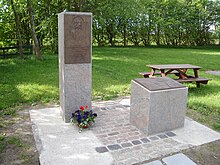Obeyed kings
As imposed polders are polders referred to on the basis of several Oktroy ( carte blanche from Latin : auctoritas , influence, prestige) were built, the private investors during the 17th and 18th centuries in which the Danish general government belonging to the Duchy of Schleswig , particularly in Nordfriesland , granted the right to dike . Other rights were often associated with this, such as B. the tax exemption of residents for a certain period. As first-rate municipalities, these kings were independent of the surrounding administrative districts in most areas.
history
Historically, land reclamation was either the task of the peasantry directly on the coast or that of the sovereign. The prerequisite for the award of Oktroy was the resolution passed by Duke Johann Adolf in 1612 , according to which the Anwachs, the foreland that could be dyed up , no longer automatically belonged to the neighboring communities, but to the authorities. This could take the right to dike into their own hands, give it to the march farmers or sell it to deserving subjects. After many projects of this kind exceeded the possibilities of those responsible and / or were destroyed by storm surges , the Oktroy made it possible to attract capital and skills from other countries without having to use local funds.
The earliest Oktroy was after 1634: In that year the Burchardi flood tore the island of Alt-Nordstrand apart. Only remnants of land - today's Nordstrand peninsula , the island of Pellworm and the Halligen Nordstrandischmoor and Hamburger Hallig - remained as fragments. The Gottorf Duke Friedrich III. first tried with his own means to re-dike former cultivated land on north beach, but failed. As a result, he exhibited Oktroy and successfully persuaded the Brabant dike count Quirinus Indervelden to secure the remaining parts of the island against the sea. Indervelden received ownership of the entire land, police rights, freedom from tax, trade privileges and freedom of religion for the mostly Catholic dyke workers whom he hired in his home country.
The Oktroy was successful, so that his son Duke Christian Albrecht subsequently issued another Oktroy. In 1681 he signed an octroy for the Dagebüller Bay. Around 220 interested parties, both from the three neighboring Harden ( Böking- , Wieding- and Karrharde ) and Gottorfer court officials , shared the financing of the dike for the Christian-Albrechts-Koog, which was then named after the duke . Each interested party was allocated land depending on their financial outlay. Among other things, the owners were exempt from all taxes for 14 years. They themselves had sovereignty over the courts, police, church and administration in the country.
In 1704 the New Christian Albrechtskoog and the Dagebüller Koog, which were directly connected to the Hallig Dagebüll at the time, were created in the same way and with similar rights. In the next hundred years, the area between the Hallig Dagebüll in the southwest and the mainland northeast of it was closed by further dikes. These were the Kleiseerkoog , the Juliane-Marien-Koog and the Marienkoog .
The second large bay that aroused interest in dikes was the one in front of Bredstedt . This area of the Wadden Sea , which was protected by the island of Nordstrand, was in the catchment area of the Nordergoesharde and thus belonged to the royal part of the entire Danish state. After Christian IV tried in the 17th century to dike the bay in one fell swoop ( Bredstedter Werk ), but repeatedly failed, his great-great-grandson King Christian VI finally forgave it . in the 18th century Oktroy to the Danish nobleman Jean Henri Desmercières and his father Jean Henri Huguetan Graf von Gyldensteen . These two succeeded in damming in the Sophie-Magdalenen-Koog and the Desmerciereskoog , as well as the Elisabeth-Sophien-Koog on the north beach, and with the first two they laid the foundation of today's Reußenköge community. The embankment of the subsequently won lands of the Reußenkooges and the Louisenkooges was also based on this Oktroy . Count (later Prince) Heinrich XLIII. benefited from the legacy of Desmercières, who had recently died.
In 1853, the total of 22 imposed kegs of the duchy - with the exception of the five Nordstrander kegs, from which the Nordstranderharde was formed - were subjected to the jurisdiction of the adjacent Harden .
literature
- Marie Luisa Allemeyer: "No country without a dike--!" Vandenhoeck & Ruprecht, 2006.
- Hans J. Jessen: Excerpt from the history of the imposed kings in addition to mentions of the dyke system and the administration in the Eiderstedt landscape . 1933.
- Rolf Kuschert: North Friesland in the early modern times. In: Nordfriisk Instituut (ed.) History of North Friesland (new edition) (Part 3). Verlag Nordfriisk Instituut Bräist / Bredstedt 2007, ISBN 978-3-88007-341-8 , pp. 123-125.
- Helmuth Römer: The legal history of the Koog and dike associations as well as the imposed Köge in Schleswig, especially in North Friesland . Leipzig 1938.
Individual evidence
- ↑ a b ( page no longer available , search in web archives )
- ↑ Allemeyer: "No country without a dike--!" , P. 139.
